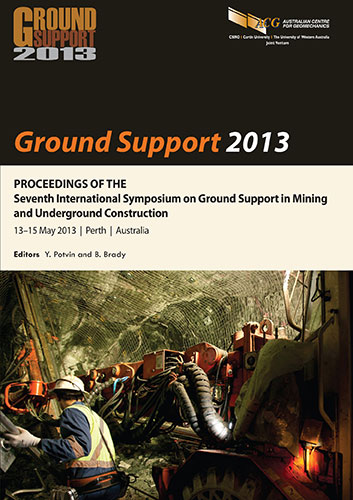Visualisation of deformation or force in rock supporting structures

|
Authors: Nishio, A; Zhang, H; Akutagawa, S; Takeya, K; Ishizuka, Y; Katayama, T Paper is not available for download Contact Us |
DOI https://doi.org/10.36487/ACG_rep/1304_46_Akutagawa
Cite As:
Nishio, A, Zhang, H, Akutagawa, S, Takeya, K, Ishizuka, Y & Katayama, T 2013, 'Visualisation of deformation or force in rock supporting structures', in Y Potvin & B Brady (eds), Ground Support 2013: Proceedings of the Seventh International Symposium on Ground Support in Mining and Underground Construction, Australian Centre for Geomechanics, Perth, pp. 657-666, https://doi.org/10.36487/ACG_rep/1304_46_Akutagawa
Abstract:
New sensors have been developed for simultaneous monitoring and visualisation of risk conditions for mining applications to achieve an advanced safety management scheme using ‘colour of light’ as a key technology of the proposed method. These sensors are designed and built based on the new monitoring concept called onsite visualisation. They are capable of: 1) sensing data; and 2) visually outputting the measurement results simultaneously by using Light Emitting Diode (LED) for workers. In this paper two new methods for visualising deformation or force in rock supporting structures, such as rockbolts or ground anchors are reviewed. Firstly a colour of light is used as the principal indicator of deformation or force in the rockbolt or ground anchor. An additional set of stiff cable and spring is used along with rockbolt or ground anchor so that the deformation can be easily measured. The measured deformation can then be translated into colour of light using a colour-filter switch. The use of this method is suited to underground spaces for ease in visual identification. Secondly, the number of plastic optical fibres receiving sunlight becomes the principal indicator of deformation or force in rock supporting structure. A specially designed mechanical switch is set on a ground anchor head. As the force changes the tendon changes its length, which then is transferred to the shift of light blocking the metal shield panel. When the shield panel moves the number of plastic optical fibres receiving sunlight changes, from which approximate values of the anchor force can be identified. Once this sensor is set, long term observation of anchor forces (limited to observation during daytime only) becomes possible without using electricity. Some experiences in using these new tools are presented and their potential in mining applications are discussed.
References:
Akutagawa, S. (2011) On-site visualization – in search of a new monitoring method, Civil Engineering Technology, Vol. 66, No. 10, pp. 53–58.
Akutagawa, S., Minami, Y., Yamachi, H., Haba, T., Hiroshima, T. and Nozawa, T. (2011) A new method for visualizing stresses in rock support measures by using a light emitting sensor, in Proceedings 12th ISRM International Congress on Rock Mechanics, Q. Qian and Y. Zhou (eds), 18–21 October 2011, Beijing, China, Taylor & Francis Group.
Akutagawa, S., Kusui, A. and Nomura, M. (2010) Light emitting sensors as new visual tool for rock structure monitoring, in Proceedings EUROCK 2010, Lausanne, pp. 609–612.
Akutagawa, S., Mori, S., Kusui, A. and Nomura, M. (2009) New concept for rock structure monitoring by light emitting sensors, in Proceedings 2009 Korea-Japan Joint Symposium on Rock Engineering, 22–23 October 2009, Suwong, Korea, pp. 347–356.
Akutagawa, S. and Yamada, H. (2009) Visualization of tunnel risks by use of light emitting deformation sensor, in Proceedings First China-Japan Workshop on Tunnelling Safety & Risk, 28–29 August 2009, Shanghai, China, pp. 49–55.
Akutagawa, S. and Mori, S. (2008) Development of new deformation sensors for monitoring of infrastructures, in Proceedings of the EIT-JSCE Joint Seminar on Rock Engineering, 16–17 September, Bangkok, Thailand, pp. 192–195.
Akutagawa, S., Takano, K. and Takenaka, T. (2007) Development of a new device to translate relative deformation into color of light and its application (in Japanese), in Proceedings General Convention for Japan Society for Civil Engineers, Hiroshima, Japan, CD-rom only, 3–01.
Fujiwara, Y. and Sakai, T. (2011) A study of lift-off test method of ground anchors, Journal of Japan Society of Civil Engineers, Ser. C (Geosphere Engineering), Vol. 67, No. 4, pp. 558–568.
Hyett, A. and Spearing, A.J.S. (2012) New Technology for Measuring the In Situ Performance of Rock Bolts, in Proceedings 46th US Rock Mechanics / Geomechanics Symposium, 24–27 June 2012, Chicago, USA, American Rock Mechanics Association, Virginia, CD-rom only, Paper ID, ARMA 12–497.
© Copyright 2025, Australian Centre for Geomechanics (ACG), The University of Western Australia. All rights reserved.
View copyright/legal information
Please direct any queries or error reports to repository-acg@uwa.edu.au
View copyright/legal information
Please direct any queries or error reports to repository-acg@uwa.edu.au